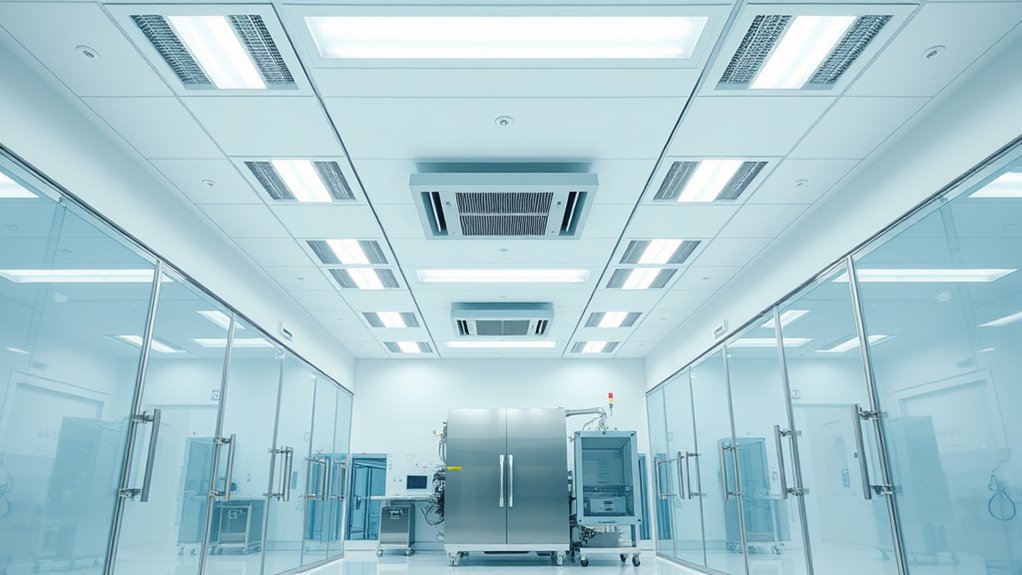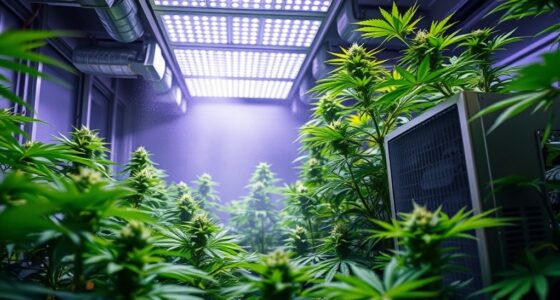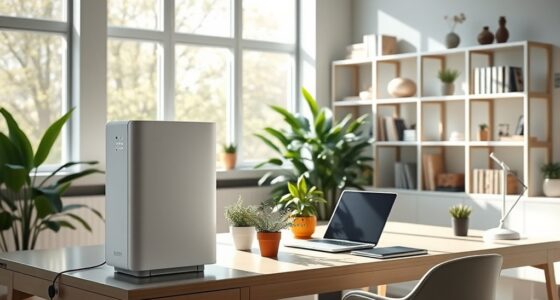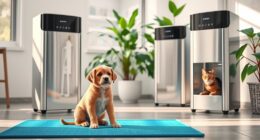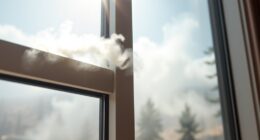To maintain high air quality in manufacturing cleanrooms, you should follow strict standards like ISO 14644 and implement effective filtration systems such as HEPA or ULPA filters. Control airflow patterns, pressure differentials, and environmental monitoring to prevent contamination. Regularly inspect and maintain equipment, ensure proper personnel procedures, and continuously validate your system’s performance. By applying these practices, you’ll keep your cleanroom compliant and safeguard product integrity—discovering more will help you master this essential aspect.
Key Takeaways
- Implement HEPA or ULPA filters within HVAC systems to effectively remove airborne particles and microbes.
- Maintain proper airflow patterns, such as unidirectional airflow and positive pressure, to prevent contamination ingress.
- Conduct regular environmental monitoring of particle counts and microbial presence to ensure ongoing air quality compliance.
- Enforce strict personnel gowning, cleaning, and movement protocols to minimize contamination risks.
- Schedule routine maintenance and validation of filtration and ventilation systems to sustain optimal cleanroom conditions.
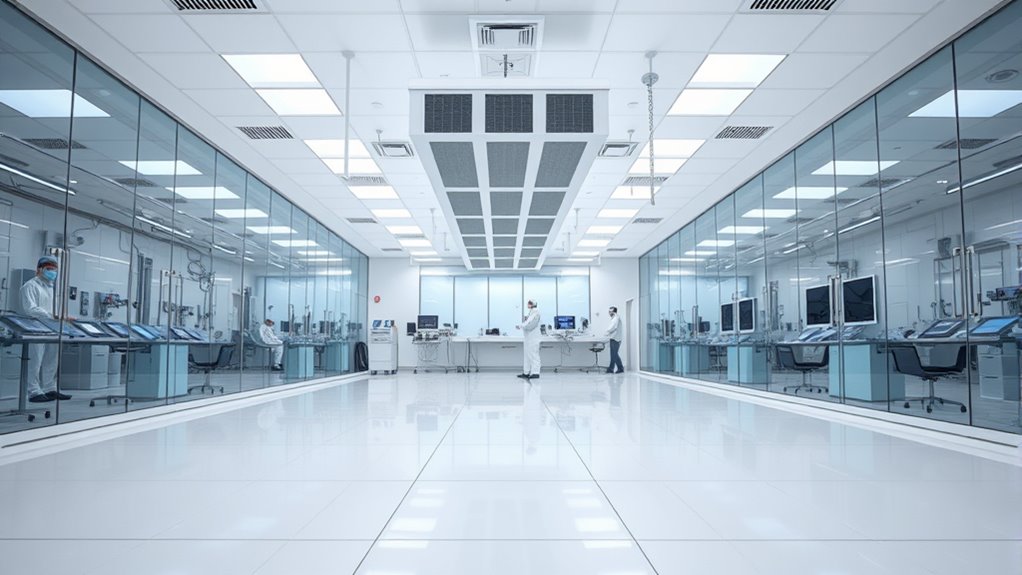
Maintaining high air quality in manufacturing cleanrooms is essential to guarantee product integrity and comply with industry standards. Your primary focus should be on effective air filtration systems that can remove airborne particles, microbes, and other contaminants. Proper air filtration is the backbone of contamination control, ensuring that the environment remains within strict cleanliness levels. When you choose the right air filters, such as HEPA or ULPA filters, you’re actively reducing the risk of contaminant infiltration. These filters trap particles as small as 0.3 microns, which include bacteria, dust, and other pollutants that could compromise product quality. Remember, the continuous operation and maintenance of these filters are crucial to sustain excellent air quality.
Contamination control isn’t just about installing filters; it’s a thorough approach that involves controlling airflow patterns, pressure differentials, and environmental monitoring. You should design your cleanroom layout to promote unidirectional airflow, which directs contaminated air away from critical areas and prevents cross-contamination. Maintaining positive pressure relative to adjacent spaces helps keep contaminants from entering the cleanroom environment. Regular checks and validation of airflow systems ensure that everything functions correctly, preventing any breaches in cleanliness standards. Incorporating efficient filtration systems into your cleanroom’s HVAC setup guarantees a consistent removal of airborne contaminants, but it’s equally important to monitor airborne particle counts and microbial presence regularly. This ongoing surveillance helps you catch any deviations early and take corrective steps before product integrity is compromised.
Additionally, contamination control involves strict gowning procedures, proper cleaning protocols, and minimizing personnel movement within the cleanroom. The air filtration system works synergistically with these practices to provide a thorough barrier against contamination. Educating your staff on best practices for contamination control ensures they understand the importance of keeping the environment clean. You should also implement routine maintenance schedules for filters, HEPA housings, and ventilation systems to prevent any performance degradation. This proactive approach reduces downtime, maintains compliance, and preserves the integrity of your products. Incorporating contamination control strategies and best practices will further strengthen your cleanroom environment.
Frequently Asked Questions
How Do Temperature Fluctuations Affect Cleanroom Air Quality?
Temperature fluctuations can disrupt your cleanroom’s air quality by impacting humidity control and airflow stability. As temperatures rise or fall unpredictably, humidity levels may become inconsistent, leading to particle buildup or static issues. These changes can cause airflow patterns to shift, reducing filtration efficiency. To maintain ideal air quality, it’s essential to regulate temperature carefully, ensuring stable conditions that support proper humidity control and consistent airflow throughout your cleanroom environment.
What Are the Latest Technological Advancements in Cleanroom Air Filtration?
You should know that recent advancements in cleanroom air filtration include enhanced HEPA filters with higher efficiency and durability. Ultraviolet sterilization is increasingly integrated to eliminate microbes without chemical use. These innovations improve air purity, reduce contamination risks, and maintain strict standards. Implementing advanced HEPA filtration combined with ultraviolet sterilization allows you to achieve better control over air quality, ensuring a safer environment for sensitive manufacturing processes.
How Often Should Cleanroom Air Quality Testing Be Conducted?
You should conduct cleanroom air quality testing regularly, typically following sampling frequency guidelines set by your industry standards or regulatory requirements. Testing protocols often recommend daily or weekly sampling, depending on your cleanroom’s classification and usage. By adhering to these schedules, you guarantee consistent monitoring, identify potential contamination issues early, and maintain compliance, keeping your environment safe and within required air quality standards.
What Training Is Required for Personnel to Maintain Air Standards?
You can’t pour from an empty cup, so start with proper training. You must guarantee personnel are certified in cleanroom protocols and undergo ongoing education to keep standards high. Regular training covers gowning procedures, contamination control, and safety measures. Staying current with evolving practices ensures your team maintains ideal air quality. Remember, continuous learning is key to safeguarding cleanroom environments and meeting industry standards effectively.
How Do External Environmental Factors Influence Cleanroom Air Quality?
External pollution and air circulation markedly influence cleanroom air quality. When external pollution levels rise, contaminants can enter through ventilation systems, compromising cleanliness. Proper air circulation helps dilute and remove these pollutants, maintaining ideal conditions. You should regularly monitor external pollution sources and guarantee your ventilation systems are functioning effectively. By controlling external factors and enhancing air circulation, you keep the cleanroom environment safe and compliant with standards.
Conclusion
Maintaining air quality in manufacturing cleanrooms is like keeping a delicate balance on a tightrope—you must follow strict standards and best practices to guarantee purity. By regularly monitoring and controlling environmental conditions, you can prevent contamination and safeguard product integrity. Remember, cleanrooms are the backbone of quality manufacturing, and your attention to air quality is what keeps everything running smoothly, like a well-oiled machine. Stay vigilant, and your cleanroom will remain a fortress of cleanliness.
